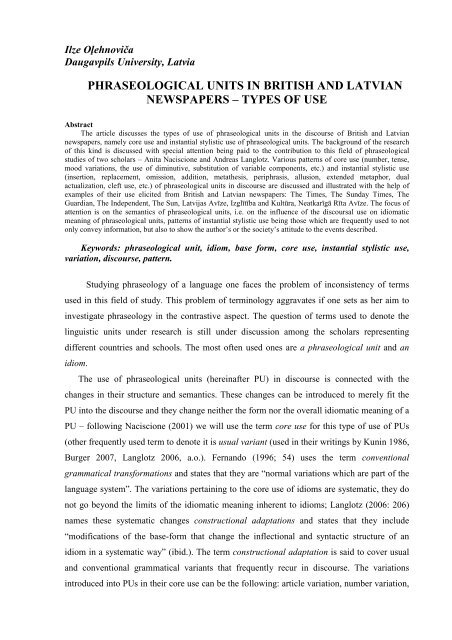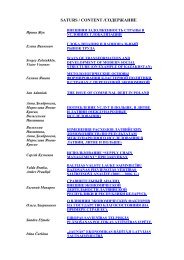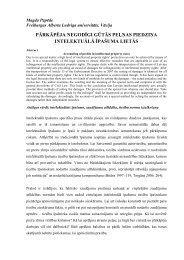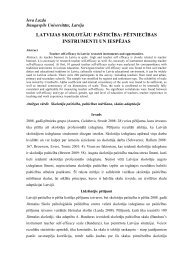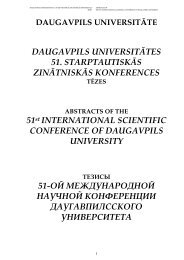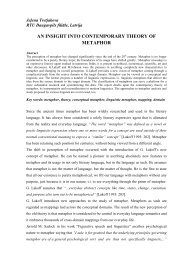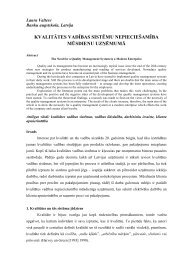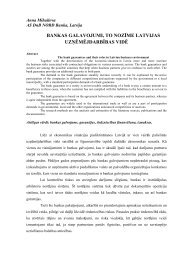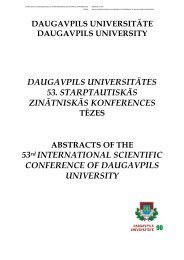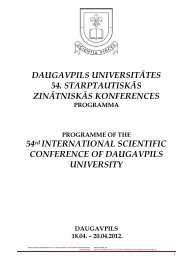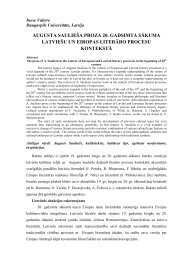phraseological units in british and latvian newspapers â types of use
phraseological units in british and latvian newspapers â types of use
phraseological units in british and latvian newspapers â types of use
Create successful ePaper yourself
Turn your PDF publications into a flip-book with our unique Google optimized e-Paper software.
Ilze OļehnovičaDaugavpils University, LatviaPHRASEOLOGICAL UNITS IN BRITISH AND LATVIANNEWSPAPERS – TYPES OF USEAbstractThe article discusses the <strong>types</strong> <strong>of</strong> <strong>use</strong> <strong>of</strong> <strong>phraseological</strong> <strong>units</strong> <strong>in</strong> the discourse <strong>of</strong> British <strong>and</strong> Latvian<strong>newspapers</strong>, namely core <strong>use</strong> <strong>and</strong> <strong>in</strong>stantial stylistic <strong>use</strong> <strong>of</strong> <strong>phraseological</strong> <strong>units</strong>. The background <strong>of</strong> the research<strong>of</strong> this k<strong>in</strong>d is discussed with special attention be<strong>in</strong>g paid to the contribution to this field <strong>of</strong> <strong>phraseological</strong>studies <strong>of</strong> two scholars – Anita Naciscione <strong>and</strong> Andreas Langlotz. Various patterns <strong>of</strong> core <strong>use</strong> (number, tense,mood variations, the <strong>use</strong> <strong>of</strong> dim<strong>in</strong>utive, substitution <strong>of</strong> variable components, etc.) <strong>and</strong> <strong>in</strong>stantial stylistic <strong>use</strong>(<strong>in</strong>sertion, replacement, omission, addition, metathesis, periphrasis, allusion, extended metaphor, dualactualization, cleft <strong>use</strong>, etc.) <strong>of</strong> <strong>phraseological</strong> <strong>units</strong> <strong>in</strong> discourse are discussed <strong>and</strong> illustrated with the help <strong>of</strong>examples <strong>of</strong> their <strong>use</strong> elicited from British <strong>and</strong> Latvian <strong>newspapers</strong>: The Times, The Sunday Times, TheGuardian, The Independent, The Sun, Latvijas Avīze, Izglītība <strong>and</strong> Kultūra, Neatkarīgā Rīta Avīze. The focus <strong>of</strong>attention is on the semantics <strong>of</strong> <strong>phraseological</strong> <strong>units</strong>, i.e. on the <strong>in</strong>fluence <strong>of</strong> the discoursal <strong>use</strong> on idiomaticmean<strong>in</strong>g <strong>of</strong> <strong>phraseological</strong> <strong>units</strong>, patterns <strong>of</strong> <strong>in</strong>stantial stylistic <strong>use</strong> be<strong>in</strong>g those which are frequently <strong>use</strong>d to notonly convey <strong>in</strong>formation, but also to show the author’s or the society’s attitude to the events described.Keywords: <strong>phraseological</strong> unit, idiom, base form, core <strong>use</strong>, <strong>in</strong>stantial stylistic <strong>use</strong>,variation, discourse, pattern.Study<strong>in</strong>g phraseology <strong>of</strong> a language one faces the problem <strong>of</strong> <strong>in</strong>consistency <strong>of</strong> terms<strong>use</strong>d <strong>in</strong> this field <strong>of</strong> study. This problem <strong>of</strong> term<strong>in</strong>ology aggravates if one sets as her aim to<strong>in</strong>vestigate phraseology <strong>in</strong> the contrastive aspect. The question <strong>of</strong> terms <strong>use</strong>d to denote thel<strong>in</strong>guistic <strong>units</strong> under research is still under discussion among the scholars represent<strong>in</strong>gdifferent countries <strong>and</strong> schools. The most <strong>of</strong>ten <strong>use</strong>d ones are a <strong>phraseological</strong> unit <strong>and</strong> anidiom.The <strong>use</strong> <strong>of</strong> <strong>phraseological</strong> <strong>units</strong> (here<strong>in</strong>after PU) <strong>in</strong> discourse is connected with thechanges <strong>in</strong> their structure <strong>and</strong> semantics. These changes can be <strong>in</strong>troduced to merely fit thePU <strong>in</strong>to the discourse <strong>and</strong> they change neither the form nor the overall idiomatic mean<strong>in</strong>g <strong>of</strong> aPU – follow<strong>in</strong>g Naciscione (2001) we will <strong>use</strong> the term core <strong>use</strong> for this type <strong>of</strong> <strong>use</strong> <strong>of</strong> PUs(other frequently <strong>use</strong>d term to denote it is usual variant (<strong>use</strong>d <strong>in</strong> their writ<strong>in</strong>gs by Kun<strong>in</strong> 1986,Burger 2007, Langlotz 2006, a.o.). Fern<strong>and</strong>o (1996; 54) <strong>use</strong>s the term conventionalgrammatical transformations <strong>and</strong> states that they are “normal variations which are part <strong>of</strong> thelanguage system”. The variations perta<strong>in</strong><strong>in</strong>g to the core <strong>use</strong> <strong>of</strong> idioms are systematic, they donot go beyond the limits <strong>of</strong> the idiomatic mean<strong>in</strong>g <strong>in</strong>herent to idioms; Langlotz (2006: 206)names these systematic changes constructional adaptations <strong>and</strong> states that they <strong>in</strong>clude“modifications <strong>of</strong> the base-form that change the <strong>in</strong>flectional <strong>and</strong> syntactic structure <strong>of</strong> anidiom <strong>in</strong> a systematic way” (ibid.). The term constructional adaptation is said to cover usual<strong>and</strong> conventional grammatical variants that frequently recur <strong>in</strong> discourse. The variations<strong>in</strong>troduced <strong>in</strong>to PUs <strong>in</strong> their core <strong>use</strong> can be the follow<strong>in</strong>g: article variation, number variation,
Izglītība un Kultūra, Neatkarīgā Rīta Avīze. No word count is possible but the volume <strong>of</strong>language we have been exposed to while collect<strong>in</strong>g the <strong>in</strong>stances <strong>of</strong> the discoursal <strong>use</strong> <strong>of</strong> PUsprobably amounts to millions <strong>of</strong> words. The number <strong>of</strong> <strong>in</strong>dividual PUs collected numberedapproximately 1,000 – 1,100, <strong>and</strong> they were listed <strong>in</strong> two tables (for the two languages:English <strong>and</strong> Latvian) <strong>in</strong> which the PUs were given <strong>in</strong> their base form, their dictionarymean<strong>in</strong>gs were checked <strong>and</strong> presented, the example <strong>of</strong> PU usage <strong>in</strong> discourse <strong>and</strong> the analysis<strong>of</strong> the type <strong>of</strong> <strong>use</strong> <strong>and</strong> the result<strong>in</strong>g effects were <strong>in</strong>cluded.Now we would like to check our tentative hypothesis that <strong>in</strong> both languages underdiscussion the systematic variations <strong>of</strong> the core <strong>use</strong> <strong>and</strong> the patterns <strong>of</strong> <strong>in</strong>stantial stylistic <strong>use</strong><strong>of</strong> PUs <strong>in</strong> newspaper discourse are similar. To prove this we will present <strong>and</strong> analyze anumber <strong>of</strong> examples <strong>of</strong> the discoursal <strong>use</strong> <strong>of</strong> PUs exemplify<strong>in</strong>g the above-mentionedvariations <strong>and</strong> patterns.At first we will consider the examples <strong>of</strong> core <strong>use</strong> <strong>of</strong> PUs elicited from Latvian<strong>newspapers</strong>.The PU kā ar (aukstu) ūdeni apliets – apliet kā ar (aukstu) ūdeni – to throw cold wateron – ‘surprised, shocked, disappo<strong>in</strong>ted’. The core <strong>use</strong> <strong>of</strong> the ideational, verbal PU is <strong>use</strong>d <strong>in</strong>the simple past tense <strong>and</strong> it describes <strong>in</strong> a concise figurative form the emotional state <strong>of</strong> thelisteners, as it evokes the picture it has been created on <strong>in</strong> the reader’s m<strong>in</strong>d <strong>and</strong> thus mak<strong>in</strong>gthem underst<strong>and</strong> how disappo<strong>in</strong>ted those people actually were.Pāris mēnešus šis kungs pētīja Latvijas situāciju, līdz nāca klajā ar ziņojumu M<strong>in</strong>istrukab<strong>in</strong>etā. Tur mūs visus aplēja kā ar aukstu ūdeni, pasakot – sākumdeklarācijas nevajagieviest.Latvijas Avīze / 2011-03-02 / Redakcijas viesis (ekonomists Guntars Krasts): Egils Līcītis, Kritikanerimsies. Bet… (p.8)In the next example two idiomatic word-comb<strong>in</strong>ations based on animal images are <strong>use</strong>dto create a contrast (antonymic relations) <strong>and</strong> help the author <strong>of</strong> these words to express his<strong>in</strong>dignation: slaucama govs – milk<strong>in</strong>g cow ‘an object <strong>of</strong> <strong>use</strong>’ <strong>and</strong> darba zirgs – work horse ‘aperson who does hard work <strong>and</strong> works tirelessly’.Valstij trūkst nodokļu filoz<strong>of</strong>ijas. Nodokļi ir <strong>in</strong>struments, ar ko valdība attīsta ekonomiku,nevis to padara par naudas iekasēšanas <strong>in</strong>strumentu vien. Bizness nav slaucama govs, tasir darba zirgs.Latvijas Avīze / 2011-03-03 / Šodien: Spilgts citāts (p.2)Another, relatively new formation which has not been registered <strong>in</strong> Latvian dictionaries,but we consider it be<strong>in</strong>g a PU as it has all the salient features <strong>of</strong> PUs – non-compositionality<strong>of</strong> mean<strong>in</strong>g, cohesion <strong>and</strong> conventionality, is the phrase nogriezt skābekli – turn <strong>of</strong>f oxygen –‘to stop, to prevent from cont<strong>in</strong>u<strong>in</strong>g’. In this example the mood <strong>of</strong> the verb is changed.
Optimistiskākie f<strong>in</strong>anšu eksperti bilst, ka pr<strong>in</strong>cipā ar tabakai un alkoholam pacelto akcīzivalsts kasi pildīt būtu iespējams, BET – kā mēdza uzsvērt viens no V. Dombrovskapriekštečiem – ar noteikumu, ka jānogriež skābeklis šo preču kontrab<strong>and</strong>ai un nelegālajaiapritei.Latvijas Avīze / 2011-03-02 / Komentāri, viedokļi: Monika Zīle, Konsolidēšanas tupiks (p.3)The <strong>use</strong> <strong>of</strong> the PU translated from Russian: вилами по воде писано –written with ahayfork <strong>in</strong> water – ‘it is not known yet if it will happen or not’ can be justified if we take <strong>in</strong>toaccount the headl<strong>in</strong>e <strong>of</strong> the article, which is “Konsolidēšanas tupiks” (“ConsolidationDeadlock”). In this example it is <strong>use</strong>d as a modifier to express the author’s evaluation <strong>of</strong> thef<strong>in</strong>ancial situation <strong>in</strong> the country. And there are three more PUs that all refer to the unpleasantsituation <strong>in</strong> the country’s economy.Bet turpat blakus ar dakšām ūdenī zīmētajam ciparam redzama arī bez problēmāmiekasējama summa, atceļot samaz<strong>in</strong>āto pievienotās vērtības likmi mājsaimniecībāspatērētajai dabasgāzei un pie vienām sāpēm paaugst<strong>in</strong>ot tai akcīzes nodokli. Iespējams,stipri manīgi ļaudis arī te atradīs spraudziņu papildus netērēties, bet vairākums tomēr būsspiesti attaisīt makus.Tiesa, viss nodokļu druvā reāli pļaujamais nošņāpts un gaisā pagrābtu ciparu ierakstīšanasvaigajā plānā liec<strong>in</strong>a: pa izvēlēto ceļu konsolidācija iebraukusi tupikā – tā šādassituācijas mēdza dēvēt augstākm<strong>in</strong>ētais V. Dombrovska priekšgājējs.Latvijas Avīze / 2011-03-02 / Komentāri, viedokļi: Monika Zīle, Konsolidēšanas tupiks (p.3)Attaisīt maku is the variation <strong>of</strong> the PU atvērt maku: one <strong>of</strong> the elements <strong>of</strong> itsconventional form has undergone lexical substitution by a synonymous verb that <strong>in</strong> no way<strong>in</strong>fluences the mean<strong>in</strong>g <strong>of</strong> the PU, so this is a regular variation.In the end <strong>of</strong> the article there is the same number mentioned but here it is modified by aLatvian PU no gaisa grābts – snatched out <strong>of</strong> th<strong>in</strong> air ‘groundless, unjustified, fictional’ thathas been subjected to the change <strong>of</strong> decl<strong>in</strong>ation <strong>in</strong> the first component <strong>and</strong> addition <strong>of</strong> theprefix <strong>in</strong> the second component. But no semantic changes have been <strong>in</strong>troduced.An example <strong>of</strong> the <strong>in</strong>fluence <strong>of</strong> the Russian language on the writ<strong>in</strong>g <strong>of</strong> Latvianjournalists is manifested also <strong>in</strong> another article, <strong>in</strong> which it is presented as it sounds <strong>in</strong> Russian<strong>and</strong> the Latvian translation is provided. Thus the author <strong>of</strong> the article expresses his ironyconcern<strong>in</strong>g the Russian – American relations.Konservatīvais Reigans pastaigājās "ļaunuma impērijas " sirdī Sarkanajā laukumā un pēclīguma parakstīšanas jokoja, atgād<strong>in</strong>ot krievu teicienu: "Doverjai, no proverjai"(„Uzticies, bet pārbaudi”).Latvijas Avīze / 2011-03-02 / Ārzemju ziņas: Valdis Bērziņš, Pārbūves aizsācējam Gorbačovam – 80 (p.11)There is also an example <strong>of</strong> an English PU be<strong>in</strong>g translated <strong>in</strong>to Latvian, namely, whitecollar workers – ‘non-manual employee, such as an <strong>of</strong>fice worker or manager’. As it is <strong>use</strong>d<strong>in</strong> <strong>in</strong>verted commas, we can state that the author’s pejorative attitude is manifested."Ir viegli saprast, kāpēc krīzes skarto Austrumeiropas valstu "baltās apkaklītes" metušāszelta skrējienā uz Briseli," raksta avīze.
Latvijas Avīze / 2011-03-02 / Latvijas ziņas(p.4): Zelta skrējiens uz BriseliNow let us turn our attention to the examples elicited from British <strong>newspapers</strong> thatexemplify the possible variations <strong>in</strong> PUs <strong>in</strong> their core <strong>use</strong>.The PU pull no punches – ‘to deal with someth<strong>in</strong>g honestly without hid<strong>in</strong>g anyth<strong>in</strong>g’(CDAI) can be presented as an example <strong>of</strong> core <strong>use</strong> with only one regular variation that isaimed at fitt<strong>in</strong>g the base form <strong>in</strong>to the context properly.British Airways boss Willie Walsh pulls no punches <strong>in</strong> a column <strong>in</strong> the company's staffmagaz<strong>in</strong>e, accus<strong>in</strong>g the Unite union <strong>of</strong> try<strong>in</strong>g to "destroy us" with <strong>in</strong>dustrial action.The Independent 2010-02-04.Bus<strong>in</strong>ess Diary: Walsh asks staff to sign up for battleAnother case <strong>of</strong> the PU core <strong>use</strong> with only systematic variations – tense adaptation <strong>and</strong>passivization is the <strong>use</strong> <strong>of</strong> the PU keep somebody <strong>in</strong> the dark – ‘to not tell someone aboutsometh<strong>in</strong>g’ (CDAI):She added: "The workforces have been kept <strong>in</strong> the dark too long. Specific questions havebeen put to Ms Rosenfeld by our European colleagues, <strong>in</strong>clud<strong>in</strong>g will the takeover lead tothe closure <strong>of</strong> exist<strong>in</strong>g plants <strong>and</strong> will there be lay-<strong>of</strong>fs? All these questions need urgentanswers."The Independent 2010-02-03. James Thompson, Kraft f<strong>in</strong>ally acquires Cadbury after vote <strong>in</strong> favour <strong>of</strong>£11.4bn dealThe follow<strong>in</strong>g <strong>in</strong>stance <strong>of</strong> the discoursal <strong>use</strong> <strong>of</strong> the PU shows the <strong>use</strong> <strong>of</strong> <strong>in</strong>appropriateregister on the part <strong>of</strong> the speaker, who, by the way, is the deputy governor <strong>of</strong> the Bank <strong>of</strong>Engl<strong>and</strong>, this deviation <strong>in</strong> formal speech be<strong>in</strong>g aimed at attract<strong>in</strong>g attention. The PU is <strong>in</strong> itscore <strong>use</strong> with no regular adaptations: when the shit hits the fan – Sl. ‘when all the expectedtrouble materializes’ (McGraw-Hill). The reason why he resorts to this <strong>in</strong>appropriate registeris expla<strong>in</strong>ed <strong>in</strong> the preced<strong>in</strong>g sentence by another PU: get someth<strong>in</strong>g across – ‘to successfullycommunicate someth<strong>in</strong>g’ (CDAI).Paul Tucker, the Bank <strong>of</strong> Engl<strong>and</strong>'s deputy governor, is a pretty polite sort <strong>of</strong> a chap, butsometimes, when you're keen to get your po<strong>in</strong>t across, it's easy to forget yourself.Testify<strong>in</strong>g to the Treasury Select Committee yesterday, Mr Tucker was eager to get MPs'attention. "When the shit hits the fan," he began.The Independent 2010-01-27. Bus<strong>in</strong>ess Dairy: The man from the Bank shocks MPsThe follow<strong>in</strong>g set <strong>of</strong> examples <strong>of</strong> discoursal <strong>use</strong> <strong>of</strong> PUs that, as it has been mentionedabove, might be considered be<strong>in</strong>g a k<strong>in</strong>d <strong>of</strong> border cases <strong>in</strong> between “pure” core <strong>use</strong> <strong>and</strong>“genu<strong>in</strong>e” <strong>in</strong>stantial stylistic <strong>use</strong> <strong>of</strong> PUs. We consider them be<strong>in</strong>g cases <strong>of</strong> <strong>in</strong>stantial stylistic<strong>use</strong> for, though the overall <strong>phraseological</strong> mean<strong>in</strong>g <strong>of</strong> a PU is preserved, it usually is mademore precise, it receives some additional connotation or is made more context- or situationrelated.The variation patterns applied are negation, <strong>in</strong>sertion, lexical substitution, repetition<strong>of</strong> a component, addition, omission, <strong>use</strong> <strong>of</strong> dim<strong>in</strong>utive, metathesis (component-ordervariation), conversion, <strong>and</strong> passivization.
The PU turēt grožus rokās ‘to h<strong>and</strong>le the ribbons’, ‘to control – English analogue PUcould be keep a firm grip on is <strong>use</strong>d <strong>in</strong> its core <strong>use</strong> <strong>and</strong> has been subjected to the <strong>in</strong>sertionspecify<strong>in</strong>g what exactly is <strong>and</strong> will be kept under control <strong>and</strong> to the repetition <strong>of</strong> the verb withtense variation aimed at emphasiz<strong>in</strong>g that the case is be<strong>in</strong>g <strong>and</strong> will stay under strict control <strong>of</strong>the court.Tiesas problēma te ir jau m<strong>in</strong>ētais nepietiekamais laiks, lai visi tiesneši būtu lietas kursā.To tiesa mēģ<strong>in</strong>a kompensēt ar striktiem lēmumiem, runātāju pārtraukšanu pusvārdā, ardemonstrēšanu, ka tā tur un turēs lietas grožus savās rokās.Neatkarīgās Rīta Avīze /2009-10-1/, Māris Krautmanis, Vai Gulbis dziedās pirmais?The PU šūpot laivu - rock the boat - ‘to ca<strong>use</strong> trouble where none is welcome; to disturba situation that is otherwise stable <strong>and</strong> satisfactory’ has been negated <strong>and</strong> there is an addition<strong>of</strong> the component no lieka (unless necessary) that gives additional <strong>in</strong>formation concern<strong>in</strong>g theparty’s pr<strong>in</strong>ciple <strong>of</strong> work.Vairāk apelējam pie tā, ka "zaļie zemnieki" visās valdībās centušies sevi pasniegt kā"stabilizējošo elementu", kas no lieka laivu nešūpošot. Kā tādu konservatīvo spēku, kuradēļ valdības nekrīt.Latvijas Avīze / 2011-03-02 / Komentāri, viedokļi: Egils Līcītis, «Vienotība» būšot dusmīga, bet nesaka,cik dusmīga (p.3)Context-determ<strong>in</strong>ed <strong>in</strong>sertion <strong>of</strong> the element on the one h<strong>and</strong> <strong>and</strong> the omission <strong>of</strong> onecomponent <strong>of</strong> the PU can be seen <strong>in</strong> the follow<strong>in</strong>g example: the PU izlietu ūdeni nesasmelsi -no <strong>use</strong> cry<strong>in</strong>g over spilt milk ‘not to get upset about smth. bad that has happened <strong>and</strong> that youcannot change’, moreover the mean<strong>in</strong>g is a little changed as it is not about gett<strong>in</strong>g upset butrather about a possibility to collect that spilt water, i.e., to improve the result. We considerthis change <strong>in</strong> the mean<strong>in</strong>g also be<strong>in</strong>g context-determ<strong>in</strong>ed as the article is about sports,namely, bobsleigh.Ar to gan nebija līdzēts, lai sasmeltu visu pirmajā braucienā izlaistīto. Melbārdim vietustarp pirmajiem 15 mūsu bobslejistu galvenais treneris S<strong>and</strong>is Prūsis esot plānojis, tačuMaskalāna sekmes viņš portālā sportacentrs.com kritizē bez žēlastības: "Nobrauca slikti,rezultāts ir atbilstošs, un ne uz ko vairāk cerēt pagaidām nevaram."Latvijas Avīze / 2011-03-01 / Sports: Egīls Jurisons, Šoreiz bez uguņošanas (p.16)In the Latvian language be<strong>in</strong>g a synthetic language with relatively free word order it isvery difficult to p<strong>in</strong>po<strong>in</strong>t <strong>in</strong>stances <strong>of</strong> metathesis – rearrangement <strong>of</strong> the components <strong>in</strong> a PU,but this could be the case. The PU <strong>use</strong>d is izstrēbt putru ‘to settle the complications created; toset right’: there is the direct object front<strong>in</strong>g (topicalization (Langlotz 2006)), there is the<strong>in</strong>sertion <strong>of</strong> a specify<strong>in</strong>g context-determ<strong>in</strong>ed post-modification <strong>and</strong> the verb is <strong>use</strong>d <strong>in</strong> thefuture <strong>of</strong> the debitive mood. But, notwithst<strong>and</strong><strong>in</strong>g all these variations the PU ma<strong>in</strong>ta<strong>in</strong>s itscohesion <strong>and</strong> readers easily grasp its <strong>phraseological</strong> mean<strong>in</strong>g.
Viss tikai mutuļo uz ļaunu un nelāgu vien, katli vārās, energotarifi atpūšas, jo būs vēllielāks sviests.Latvijas Avīze / 2011-03-03 / Komentāri, viedokļi: Egils Līcītis, Katli vārās! (p.3)The image <strong>of</strong> the PU būt vienā laivā – be <strong>in</strong> the same boat ‘be <strong>in</strong> the same unpleasantsituation’ is susta<strong>in</strong>ed by add<strong>in</strong>g to its image also the way <strong>of</strong> its control – row<strong>in</strong>g <strong>and</strong> contextdeterm<strong>in</strong>edspecification that makes readers to cont<strong>in</strong>ue th<strong>in</strong>k<strong>in</strong>g on the figurative level stillreceiv<strong>in</strong>g essential <strong>in</strong>formation.Kaut situācija, protams, nepavisam nav identiska – ES valstis atrodas vienā laivā, kautpastāv grūtības ar tās airēšanu vienā virzienā, un visi ir ie<strong>in</strong>teresēti, lai arābu tautasatbrīvotos no senilajām korumpētajām diktatūrām un baudītu, eirokrātiski izsakoties, labupārvaldību un cienīgu dzīvi savās valstīs, nevis meklētu laimi svešumā.Latvijas Avīze / 2011-03-03 / Komentāri, viedokļi: Uldis Šmits, Diplomātiskās vētras (p.3)The image <strong>of</strong> the PU ēst vienam otru – to eat one another ‘to do harm to one another’that is <strong>of</strong>ten referred to as “Latvian national food” is susta<strong>in</strong>ed by the verb phrase the head <strong>of</strong>which is compatible with the verb <strong>of</strong> the PU under the hyperonym to consume: to eat, not t<strong>of</strong><strong>in</strong>d fault with some food <strong>and</strong> the cla<strong>use</strong> susta<strong>in</strong><strong>in</strong>g the image <strong>of</strong> a half-eaten, bleed<strong>in</strong>gassociate.Var teikt, viņi sastāda nošaujamo lielo politisko zvēru piecnieku – tas vilkatis, taslietuvēns un šitas sumpurnis… – un tad rīb<strong>in</strong>a kā siluetu šautuvē, lai dabūtu noņemt ragusun novilkt ādas kā tr<strong>of</strong>ejas. Viņi ēd otru latvieti, nesmādējot pat apvienības biedru, kuršatvilkts, aiz sevis atstājot asiņa<strong>in</strong>u sliedi.Latvijas Avīze / 2011-03-04 / Komentāri, viedokļi: Egils Līcītis, Aizšauts garām, nopūdelēts (p.3)The pattern <strong>of</strong> <strong>in</strong>stantiation – contam<strong>in</strong>ation – can be exemplified by the next example:two PUs Kad vadzis pilns, tas lūst <strong>and</strong> mērs ir pilns have been jo<strong>in</strong>ed to make up one mean<strong>in</strong>gthat ‘if there are too many bad th<strong>in</strong>gs, one cannot st<strong>and</strong> it anymore’:Konkrētajā gadījumā domāju, ka pie visa va<strong>in</strong>ojama ekonomiskā situācija valstī. Pieaugcenas, nodokļi, parādi, viss nelāgais krājas mūsu galvās un gadās, ka vadzis lūst, ja mērsir pilns. Visi mēs lielākā vai mazākā mēra esam pakļauti stresam. Kuram varbūt tā psihenestabilāka, tas var rīkoties neadekvāti.Latvijas Avīze / 2011-03-03 / Atpūta. Vaļasprieks: Aldis Jermaks, Reizi mūžā izšauj arī tukša pl<strong>in</strong>te (p.15)The next example is the discoursal <strong>use</strong> <strong>of</strong> the PU savilkt jostu ciešāk. It is <strong>in</strong>terest<strong>in</strong>g tonote that the mean<strong>in</strong>g <strong>of</strong> the PU <strong>in</strong> Latvian has changed <strong>in</strong> the course <strong>of</strong> time <strong>and</strong> under the<strong>in</strong>fluence <strong>of</strong> contemporary life. In the Dictionary <strong>of</strong> Latvian Phraseology (Laua 1996) it isgiven as SAVILKT (SAJOZT) JOSTU CIEŠĀK ‘iztikt ar trūcīgāgu uztura devu’ (‘to getalong with less food’), but <strong>in</strong> this article (as well as <strong>in</strong> some others – the author’s observation)it is <strong>use</strong>d <strong>in</strong> the mean<strong>in</strong>g ‘to economize’ (<strong>and</strong> not only on food) similar to the English PU totighten one’s belt ‘to beg<strong>in</strong> to exercise thrift <strong>and</strong> frugality’. Apart from this the PU <strong>in</strong> this<strong>in</strong>stance has been <strong>in</strong>stantiated: the component ciešāk has been substituted by the phrase parvienu iedaļu thus featur<strong>in</strong>g the literal-scene manipulation which although does not change the
overall mean<strong>in</strong>g <strong>of</strong> the PU but helps the author <strong>of</strong> the article to emphasize that it is not thefirst time that the people are asked (or rather made) to economize. In this case it is thewordplay on the literal mean<strong>in</strong>g <strong>of</strong> the image <strong>of</strong> the PU josta – a belt – to tighten it by onemore section, section be<strong>in</strong>g the element that is understood literally.Negrozāmo patiesību pieņemot, varētu nopūsties un savilkt jostu vēl par vienu iedaļu, kāklusībā esam piekrituši darīt, uzticoties tagadējam M<strong>in</strong>istru kab<strong>in</strong>etam, kurš līdztekusikdienas pienākumiem jau čakli plāno – tā izteicās f<strong>in</strong>anšu m<strong>in</strong>istrs – 2012. gada budžetakonsolidāciju.Latvijas Avīze / 2011-03-02 / Komentāri, viedokļi: Monika Zīle, Konsolidēšanas tupiks (p.3)The corpus <strong>of</strong> examples <strong>of</strong> discoursal <strong>use</strong> <strong>of</strong> PUs <strong>in</strong> British newspaper also yields a lot<strong>of</strong> <strong>in</strong>terest<strong>in</strong>g results.In the follow<strong>in</strong>g extract two PUs are <strong>use</strong>d: <strong>in</strong> the first PU bridge the gap – ‘to make aconnection where there is a great difference’ (CDAI) one <strong>of</strong> the components is substituted bya synonymous noun <strong>and</strong> made more context-related, <strong>and</strong> the verb is converted <strong>in</strong>to anadjective <strong>and</strong> negated stress<strong>in</strong>g that the situation is irreversible, while the 2 nd PU on speak<strong>in</strong>gterms – ‘friendly enough to talk’ is <strong>in</strong> its core <strong>use</strong>.As he moved out, progressed <strong>in</strong> his career <strong>and</strong> married, the gulf with his mother becameunbridgeable. They were not on speak<strong>in</strong>g terms when she died.The Times 2010-01-26. Peta Bee, Are British men becom<strong>in</strong>g mummy’s boys too?The pattern <strong>of</strong> dual actualization achieved by the help <strong>of</strong> the <strong>in</strong>sertion, namely, thetopic-related literal scene manipulation (see Langlotz 2006; 212) is featured <strong>in</strong> the nextexample <strong>of</strong> the <strong>in</strong>stantial stylistic <strong>use</strong> <strong>of</strong> the PU <strong>in</strong> heaven – ‘<strong>in</strong> a state <strong>of</strong> absolute bliss orhapp<strong>in</strong>ess’ (McGraw-Hill). The pre-modifier <strong>in</strong>serted <strong>in</strong>to the constituent structure <strong>of</strong> the PUcannot be attributed a figurative <strong>in</strong>terpretation on the level <strong>of</strong> <strong>phraseological</strong> mean<strong>in</strong>g, it canbe <strong>in</strong>terpreted only literally. Thus variable-rate applies literally to mortgage rates <strong>and</strong> shouldbe thus understood while the underly<strong>in</strong>g PU is to be understood idiomatically.Low <strong>in</strong>terest rates are still mask<strong>in</strong>g the scale <strong>of</strong> the crisis, beca<strong>use</strong> many people who wereworried about their mortgages two years ago are now <strong>in</strong> variable-rate heaven.Times Onl<strong>in</strong>e. 2010-05-05, Camilla Cavendish, Call <strong>in</strong> the IMF to tell us how bad it really isThe follow<strong>in</strong>g newspaper extract shows three patterns <strong>of</strong> variation, namely, the topic<strong>in</strong>dication that is achieved by addition <strong>of</strong> the element trophy, the negation, <strong>and</strong> the pattern <strong>of</strong>extended metaphor. The idiomatic mean<strong>in</strong>g <strong>of</strong> the PU is not only preserved but even susta<strong>in</strong>edthus creat<strong>in</strong>g cohesive ties between two cla<strong>use</strong>s: the phrase a love affair, also <strong>use</strong>didiomatically <strong>in</strong> the first cla<strong>use</strong>, perta<strong>in</strong>s to the <strong>phraseological</strong> mean<strong>in</strong>g <strong>of</strong> the PU <strong>in</strong> thesecond cla<strong>use</strong>: Absence makes the heart grow fonder. ‘Be<strong>in</strong>g apart from someone that youlove makes you love them even more’
Gerrard closed his memoir by say<strong>in</strong>g he <strong>and</strong> Liverpool were “a love affair that wouldnever, ever end” but trophy-absence does not make the heart grow fonder.The Sunday Times. 2010-05-23. Jonathan Northcr<strong>of</strong>t, ‘I went mad th<strong>in</strong>k<strong>in</strong>g about the future. I won’t makethat mistake this time’The follow<strong>in</strong>g <strong>in</strong>stance is the <strong>use</strong> <strong>of</strong> the PU <strong>in</strong> the headl<strong>in</strong>e <strong>and</strong> the substitution <strong>of</strong> twoma<strong>in</strong> elements due to which the PU is be<strong>in</strong>g ambiguated, i.e. the pattern <strong>of</strong> dual actualizationis <strong>use</strong>d. The PU <strong>use</strong>d is put the cart before the horse - ‘to do th<strong>in</strong>gs <strong>in</strong> the wrong order’(CID); ‘to have th<strong>in</strong>gs conf<strong>use</strong>d <strong>and</strong> mixed up’ (McGraw-Hill) but both nouns are substitutedby caution <strong>and</strong> ideology correspond<strong>in</strong>gly. Thus a novel literal mean<strong>in</strong>g is created that has itsown reference to the context. But the base form <strong>of</strong> the PU can still be recognized <strong>and</strong> <strong>in</strong> sucha way the idiomatic mean<strong>in</strong>g with the novel literal mean<strong>in</strong>g is co-activated.A welcome case <strong>of</strong> putt<strong>in</strong>g caution before ideologyThe Independent 2011-01-20. Adrian Hamilton: A welcome case <strong>of</strong> putt<strong>in</strong>g caution before ideologyThe same is true also for the next example, <strong>in</strong> which the same PU has undergone thesame type <strong>of</strong> <strong>in</strong>stantiation result<strong>in</strong>g <strong>in</strong> to put country before party.It will comm<strong>and</strong> a healthy majority <strong>in</strong> the Commons. It will require politicians to putcountry before party. It will free the best people to ab<strong>and</strong>on some <strong>of</strong> the “party politicalbicker<strong>in</strong>g, gr<strong>and</strong>st<strong>and</strong><strong>in</strong>g <strong>and</strong> po<strong>in</strong>t scor<strong>in</strong>g” that David Cameron warned aga<strong>in</strong>st onFriday. It will enable both sides to drop manifesto policies that clashed with brutaleconomic reality.The Times. 2010-05-12. Camilla Cavendish. Our democracy has emerged <strong>in</strong>tact, arguably healthier thanever beforeThe PU tighten your belt – ‘to spend less than you did before beca<strong>use</strong> you have lessmoney’ (CID) is <strong>in</strong> its <strong>in</strong>stantial stylistic <strong>use</strong> – extended metaphor: the image <strong>of</strong> the base formis susta<strong>in</strong>ed <strong>and</strong> supported by additional images perta<strong>in</strong><strong>in</strong>g to the same semantic field: cutt<strong>in</strong>gaway fat, belt fit more comfortably. Besides, the author helps his readers to keep th<strong>in</strong>k<strong>in</strong>g onthe idiomatic level by specify<strong>in</strong>g the type <strong>of</strong> belt – money belt.Many pr<strong>of</strong>essionals <strong>in</strong> frontl<strong>in</strong>e services such as health <strong>and</strong> education agree that it is goodthat the time has come for belts to be tightened. They feel that by cutt<strong>in</strong>g away the fat,the money belt can fit more comfortably round the muscles <strong>and</strong> s<strong>in</strong>ews that ma<strong>in</strong>ta<strong>in</strong>essential activities.Times Onl<strong>in</strong>e. 2010-05-21. Jonathan Waxman, Take the scalpel to the NHS. It’ll leave no scar.Play with two PUs both <strong>use</strong>d idiomatically <strong>and</strong> the constituent notional component <strong>of</strong>the second be<strong>in</strong>g pseudo-homonym <strong>of</strong> the notional component <strong>of</strong> the first PU is featured <strong>in</strong>the follow<strong>in</strong>g extract. Both PUs are <strong>use</strong>d <strong>in</strong> their idiomatic mean<strong>in</strong>g, i.e., there is no switchbetween the literal <strong>and</strong> the figurative mean<strong>in</strong>gs <strong>in</strong>tended, but it still produces humorous effect.The PUs <strong>use</strong>d are: on the bl<strong>in</strong>k ‘not operat<strong>in</strong>g well’ (CDAI); on the br<strong>in</strong>k <strong>of</strong> smth. – ‘ifsomeone or someth<strong>in</strong>g is on the br<strong>in</strong>k <strong>of</strong> a situation, that situation is likely to happen soon’(CID).
The ro<strong>of</strong> leaks <strong>and</strong> the boiler <strong>and</strong> the doorbell have been on the bl<strong>in</strong>k for months. Myeight-year-old has p<strong>in</strong>ned a sign that says “please bang” to the front door. My bra<strong>in</strong> is onthe bl<strong>in</strong>k. Or do I mean the br<strong>in</strong>k? Please bang.The Times. 2010-04-09. Camilla Cavendish, Why is it ‘brave’ to want children <strong>and</strong> a career?The possibility to <strong>in</strong>troduce changes <strong>in</strong>to the structure <strong>and</strong> mean<strong>in</strong>g <strong>of</strong> PUs is a pragmaticvalue as it gives the author an opportunity to present def<strong>in</strong>ite semantic content <strong>in</strong> an unusualform thus also achiev<strong>in</strong>g certa<strong>in</strong> aims. Be<strong>in</strong>g segmentally complex (compositional <strong>in</strong> form)expressions with more or less idiomatic mean<strong>in</strong>g (partial or complete mean<strong>in</strong>g transfer), PUsmay be subjected to contextual transformations. The most serious transformations are thosewhich <strong>in</strong>fluence both the form <strong>and</strong> the mean<strong>in</strong>g <strong>of</strong> PUs, i.e., creative idiomaticity (oridiomatic creativity (see Langlotz 2006)). The PUs that most easily lend themselves to varioustransformations are those which have lively <strong>in</strong>ternal form, i.e. they are <strong>in</strong> active <strong>use</strong>. This factis easy to expla<strong>in</strong> as such PUs have dynamic connection with their proto<strong>types</strong> <strong>and</strong> it is notdifficult for a reader to recall the base form <strong>of</strong> an <strong>in</strong>stantiated PU. What happens <strong>in</strong> cases <strong>of</strong>creative idiomaticity is that the image ly<strong>in</strong>g <strong>in</strong> the basis <strong>of</strong> an idiom is be<strong>in</strong>g renovated <strong>and</strong>revived. In general, different <strong>types</strong> <strong>of</strong> idiom <strong>in</strong>stantiation <strong>in</strong> discourse are dependent on thecommunicative goals <strong>of</strong> the writer, but the significance <strong>of</strong> one or another type <strong>of</strong> <strong>in</strong>stantiationis determ<strong>in</strong>ed by the peculiarities <strong>of</strong> the reader’s comprehension, as well as by the strength <strong>of</strong>the impact <strong>of</strong> an <strong>in</strong>stantiated PU on the reader’s thoughts <strong>and</strong> emotions.Unlike stylistically normative, core <strong>use</strong> <strong>of</strong> idioms, i.e., with stable structure <strong>and</strong>semantics, registered <strong>in</strong> dictionaries, those which are structurally <strong>and</strong> semantically modified,i.e., <strong>in</strong>stantiated idioms possess <strong>in</strong>tensified figurativeness, emotional <strong>and</strong> expressivecolour<strong>in</strong>g, they help the authors to express their evaluation <strong>of</strong> objects <strong>and</strong> phenomena, toconvey the idea <strong>in</strong> a more orig<strong>in</strong>al way. The <strong>in</strong>stantial stylistic <strong>use</strong> <strong>of</strong> idioms embellishes theauthor’s language, makes it more figurative, turns <strong>in</strong>to a tool <strong>of</strong> the writer’s ideology <strong>and</strong>aesthetic feel <strong>and</strong> performs an important role <strong>in</strong> the expression <strong>of</strong> his <strong>in</strong>dividual style.In conclusion we would like to say that the l<strong>in</strong>guistic awareness <strong>of</strong> today’s readersdem<strong>and</strong>s some wordplay, <strong>in</strong>troduction <strong>of</strong> a range <strong>of</strong> various l<strong>in</strong>guistic means. There is aspecial dem<strong>and</strong> for wit, expressivity, ultimate freedom <strong>in</strong> associations <strong>and</strong> means <strong>of</strong> theirl<strong>in</strong>guistic implementation. On the other h<strong>and</strong>, a reader has to be able to comprehend images,metaphorical manifestations <strong>of</strong> new underst<strong>and</strong><strong>in</strong>g <strong>of</strong> the world. Therefore readers’ attentionis <strong>of</strong>ten attracted by means <strong>of</strong> semantic potential <strong>of</strong> idioms, i.e., by the effect <strong>of</strong>understatement, a h<strong>in</strong>t, allusion, wordplay, which all lead to <strong>in</strong>tensification <strong>of</strong> connotativeaspect <strong>of</strong> <strong>phraseological</strong> mean<strong>in</strong>g.
References1. Burger, H. (ed.) (2007) Phraseology. An International H<strong>and</strong>book <strong>of</strong> ContemporaryResearch. Vol.1., Berl<strong>in</strong>: Walter de Gruyter GmbH & Co.KG.2. Cook, J. (1994) Discourse <strong>and</strong> Literature: The Interplay <strong>of</strong> Form <strong>and</strong> M<strong>in</strong>d. Oxford:Oxford University Press.3. Fern<strong>and</strong>o, Ch. (1996) Idioms <strong>and</strong> Idiomaticity. Oxford: Oxford University Press.4. Fern<strong>and</strong>o, Ch., Flavell R. 1981. On Idiom: Critical Views And Perspectives. In: ExeterL<strong>in</strong>guistic Studies, 5. Exeter: University <strong>of</strong> Exeter. Pp.18-48.5. Feyaerts K. 2006. Towards a Dynamic Account <strong>of</strong> Phraseological Mean<strong>in</strong>g: CreativeVariation <strong>in</strong> Headl<strong>in</strong>es <strong>and</strong> Conversational Humour. International Journal <strong>of</strong> EnglishStudies, Vol.6 (1).6. Frazer, B. (1970) Idioms with<strong>in</strong> a Transformational Grammar. Foundations <strong>of</strong>Languages, 6.7. Gläser, R. (1998) The Stylistic Potential <strong>of</strong> Phraseological Units <strong>in</strong> the Light <strong>of</strong> GenreAnalysis In: Cowie, A. (Ed.). Phraseology. Theory, Analysis, <strong>and</strong> Applications.Oxford: Clarendon Press. Pp. 23-54.8. Langaker, R. (2001) Discourse <strong>in</strong> Cognitive Grammar. Cognitive L<strong>in</strong>guistics 12(2):143-188.9. Langlotz, A. (2006). Idiomatic Creativity: a Cognitive-L<strong>in</strong>guistic Model <strong>of</strong> Idiom-Representation <strong>and</strong> Idiom Variation <strong>in</strong> English. John Benjam<strong>in</strong>s B.V.10. Moon, R. (1992) Textual Aspects <strong>of</strong> Fixed Expressions <strong>in</strong> Learners’ Dictionaries. In:Arnaud P.J.L., Bejo<strong>in</strong>t H. (eds.). Vocabulary <strong>and</strong> Applied L<strong>in</strong>guistics. London:Macmillan.11. Moon, R. (1998) Fixed Expressions <strong>and</strong> Idioms <strong>in</strong> English. Oxford: Clarendon Press.12. Naciscione, A. 1999. The Reflection <strong>of</strong> the Stylistic Use <strong>of</strong> Phraseological Units <strong>in</strong>Dictionaries <strong>of</strong> Idioms <strong>and</strong> Proverbs. Contrastive <strong>and</strong> Applied L<strong>in</strong>guistics. ContrastiveStudies VIII. Riga: University <strong>of</strong> Latvia.13. Naciscione, A. (2001) Phraseological Units <strong>in</strong> Discourse: Towards Applied Stylistics.Riga: Latvian Academy <strong>of</strong> Culture.14. Naciscione, A. (2002) Cohesion <strong>in</strong> Phraseology. In: Braasch, A., Povlsen, C. (eds.).Proceed<strong>in</strong>gs <strong>of</strong> the Tenth EURALEX International Congress, EURALEX 2002, Vol.2.Copenhagen: Center for Sprogteknologi. Pp. 534-539.15. Naciscione, A. (2010) Stylistic Use <strong>of</strong> Phraseological Units <strong>in</strong> Discourse.Amsterdam/Philadelphia: John Benjam<strong>in</strong>s Publish<strong>in</strong>g Company16. Prodromou, L. (2007) Bump<strong>in</strong>g <strong>in</strong>to Creative Idiomaticity. English Today 89, Vol.23,No.1. UK: Cambridge University Press.17. Veisbergs, A. (2001) Occasional Transformations <strong>of</strong> Idioms, Wordplay <strong>in</strong>Interpret<strong>in</strong>g. Contrastive <strong>and</strong> Applied L<strong>in</strong>guistics. Contrastive Studies X. Riga:University <strong>of</strong> Latvia.18. Кунин, A.B. (1972) Проблемы лингвистической стилистики. Москва:Международные отношения19. Кунин, А.B. (1972) Фразеология современного английского языка. Москва:Международные отношения.20. Кунин А.B. (1986) Курс фразеологии современного английского языка, Москва:Высшая школа.Lexicographical sources:1. CID - Cambridge Idioms Dictionary (2006) Cambridge University Press.2. CDAI – Cambridge Dictionary <strong>of</strong> American Idioms (2003) Cambridge UniversityPress.3. Laua A. Latviešu frazeoloģijas vārdnīca. Rīga: Avots, 1996.4. McGraw-Hill – McGraw-Hill Dictionary <strong>of</strong> American Idioms <strong>and</strong> Phrasal Verbs.(2002) The McGraw-Hill Companies, Inc.


